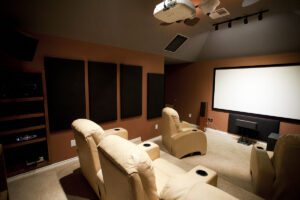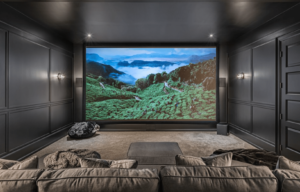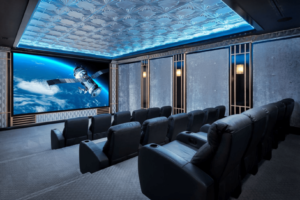Building the Ultimate Home Theater: A Guide to Sound System Setup
8 min read
Creating the ultimate home theater experience involves more than just a high-definition projector and a massive screen. One of the key elements that can truly elevate your home entertainment setup is the sound system. A well-designed sound system can immerse you in the action, making you feel like you’re part of the movie or concert. In this guide, we’ll delve into the intricacies of setting up the perfect sound system for your home theater.
If you lack money to invest into building your ultimate home theater, you can turn to loan servicing for hard money lenders for a loan!
Understanding Acoustics

Before diving into speaker selection and placement, it’s essential to understand the role of acoustics in your home theater. Acoustics refers to how sound behaves in a given space, influenced by factors such as room size, shape, and materials. A room with poor acoustics can result in sound reflections, echoes, and uneven frequency response, detracting from the overall audio experience. To optimize acoustics, consider incorporating acoustic treatments such as absorptive panels, diffusers, and bass traps into your home theater design.
When positioning your speakers, aim for balanced sound distribution throughout the room. The ideal speaker placement may vary depending on the size and layout of your space, but generally, you’ll want to create a cohesive soundstage where each speaker contributes to a seamless audio experience. Experiment with speaker placement by testing different configurations and listening positions to find the optimal arrangement for your room.
If you want to rest before watching a movie in your theatre make sure to visit the best bodywork in Austin.
Choosing the Right Speakers
Selecting the right speakers is crucial for achieving high-quality sound reproduction in your home theater. There are various types of speakers to choose from, including floor-standing, bookshelf, in-wall, and ceiling speakers, each with its own set of advantages and considerations. When choosing speakers, prioritize factors such as frequency response, power handling, and sensitivity to ensure compatibility with your audio equipment and room size.
When it comes to subwoofers, opt for a model that can reproduce deep, impactful bass without overpowering the rest of the audio spectrum. Subwoofer placement plays a significant role in bass performance, with corner placement often resulting in boomy bass and mid-wall placement offering more balanced bass distribution. Experiment with subwoofer placement and room positioning to achieve optimal bass response in your home theatre. If you need someone to take care of you while you watch your favourite movie in your hoe theatre consider the best personal care services in Dallas, TX.
Amplification and Receiver Selection
In addition to speakers, amplification and receiver selection are critical components of your home theater sound system. Amplifiers provide the necessary power to drive your speakers, ensuring clean and distortion-free audio playback at various volume levels. When choosing an amplifier, consider factors such as power output, impedance matching, and compatibility with your speaker setup.
A receiver serves as the central hub of your home theater system, handling audio and video processing, source switching, and connectivity features. Look for a receiver with ample inputs and outputs to accommodate your audio and video sources, including Blu-ray players, gaming consoles, streaming devices, and cable boxes. Additionally, ensure that the receiver supports the latest audio formats such as Dolby Atmos and DTS:X for immersive surround sound experiences.
Calibration and Fine-Tuning
Once you’ve assembled your home theater sound system, it’s essential to calibrate and fine-tune the audio settings to optimize performance. Most receivers offer built-in calibration systems that use a microphone to measure speaker distances, levels, and frequency response, automatically adjusting settings for optimal sound quality. Alternatively, you can manually adjust settings such as speaker levels, crossover frequencies, and room correction equalization to fine-tune the audio to your preferences. For additional assistance in mastering these adjustments, consider consulting a comprehensive career guide book on home theater setup and optimization.
When calibrating your home theater system, pay attention to details such as speaker placement, room dimensions, and seating arrangement, as these factors can significantly impact audio performance. Experiment with different listening positions and calibration settings to find the sweet spot where the audio sounds balanced and immersive throughout the room. Don’t hesitate to seek professional assistance if you’re unsure about calibration procedures or encounter challenges in optimizing your home theater sound system. For an added touch of style, consider retro designer furniture in Los Angeles to complement your home theater setup and enhance the overall aesthetic appeal.
Expanding Your Audio Repertoire
Now that you’ve established the foundation of your home theater sound system, it’s time to explore ways to expand your audio repertoire and enhance the versatility of your setup. In addition to traditional movie watching, consider Mike Mentzer workout routine as another form of media and entertainment to incorporate into your home theater experience. Alongside video games, music concerts, and live sports events, integrating fitness routines can add a dynamic dimension to your audio journey. Each type of content presents unique audio challenges and opportunities, allowing you to showcase the full potential of your sound system.
Immersive Gaming Experience
For avid gamers, a home theater can serve as the ultimate gaming sanctuary, offering immersive audio experiences that enhance gameplay and immersion. With the rise of virtual reality (VR) gaming and surround sound technologies, gamers can enjoy heightened realism and spatial awareness, allowing them to pinpoint enemy locations, react to environmental cues, and immerse themselves in virtual worlds like never before. To optimize your home theater for gaming, consider investing in gaming-specific audio equipment such as gaming headphones, soundbars with dedicated gaming modes, and surround sound systems with low-latency processing for seamless audio synchronization with gameplay.
Live Music Concerts

Bring the excitement of live music concerts into your home theater with high-fidelity audio reproduction and concert-like ambiance. Whether you’re a fan of rock, jazz, classical, or electronic music, a well-designed sound system can recreate the energy and excitement of a live performance, allowing you to experience your favorite artists in the comfort of your own home. Explore streaming services and concert recordings in high-resolution audio formats such as FLAC and DSD to enjoy studio-quality sound with pristine clarity and detail. Consider hosting music listening parties or themed events to share your passion for music with friends and family in an immersive audio environment.
If you are running into allergy problems in your theatre consider visiting the best clinic that does diagnostic endoscopy in Wausau.
Sports Viewing Parties
Transform your home theater into the ultimate sports viewing destination for game day gatherings and watch parties with friends and family. With the right audio setup, you can capture the dynamic energy and atmosphere of live sports events, from the roar of the crowd to the commentator’s play-by-play commentary. Enhance the excitement of game day with surround sound systems that provide immersive stadium-like audio, complete with crowd noise simulation and spatial audio effects. Consider incorporating multi-screen displays and video walls to create a larger-than-life viewing experience, allowing everyone to catch every thrilling moment of the game from any seat in the room. And don’t forget to add a TV rise stand to optimize the viewing angle for everyone in the room.
Customization and Personalization
One of the advantages of building a home theater sound system is the ability to customize and personalize the audio experience according to your preferences and tastes. Experiment with different audio settings, equalization presets, and sound modes to tailor the sound signature to suit your listening preferences and room acoustics. Explore advanced audio technologies such as room correction software, parametric equalization, and immersive audio processing to fine-tune the audio performance and achieve sonic perfection. That’s why heating repair in Charlotte NC is essential, ensuring that your viewing experience isn’t disrupted by uncomfortable temperature fluctuations.
Integrated Smart Home Features
Integrate your home theater sound system with smart home automation features to streamline control and enhance convenience. Explore voice-controlled audio systems that allow you to adjust volume, switch inputs, and play music using simple voice commands. Incorporate smart lighting, motorized curtains, and automated seating systems to create a fully immersive entertainment environment that responds to your preferences and enhances the overall viewing experience. With the power of smart home technology, you can transform your home theater into a futuristic entertainment hub that’s both intuitive and intelligent. Plus, with limo service in Atlanta, you can ensure your guests arrive in style for an unforgettable movie night.
Interactive Audio Experiences
Explore interactive audio experiences and immersive storytelling formats that blur the lines between traditional media and interactive entertainment. With the rise of audio-based gaming, interactive fiction, and augmented reality (AR) experiences, you can engage with audio content in new and innovative ways that challenge your perception and imagination. Experiment with binaural audio recordings, 3D soundscapes, and spatial audio effects to create interactive audio experiences that transport you to virtual worlds, challenge your senses, and redefine the boundaries of storytelling and entertainment. Whether you’re a casual listener, a seasoned gamer, or an event host looking to elevate your gatherings, the possibilities are endless.
Exploring Emerging Audio Technologies
As technology continues to evolve, so too does the landscape of home theater audio. Emerging audio technologies promise to revolutionize the way we experience sound in our home entertainment setups, offering new possibilities for immersion, realism, and interactivity. From object-based audio to haptic feedback systems, these cutting-edge innovations are reshaping the future of home theater audio and pushing the boundaries of what’s possible in immersive entertainment.
Object-Based Audio
Object-based audio represents a paradigm shift in audio production and playback, allowing sound engineers to create immersive audio experiences with unprecedented precision and flexibility. Unlike traditional channel-based audio formats, which assign sounds to specific speaker channels, object-based audio treats sounds as individual “objects” in a three-dimensional space, allowing for dynamic positioning, movement, and interaction within a virtual soundstage. With object-based audio technologies such as Dolby Atmos and DTS:X, filmmakers and content creators can create lifelike audio experiences that envelop the listener from all directions, heightening immersion and realism in movies, games, and virtual reality experiences.
Haptic Feedback Systems

In addition to immersive audio, haptic feedback systems are emerging as a promising technology for enhancing the sensory experience of home theater entertainment. Haptic feedback, also known as tactile feedback, simulates the sense of touch by applying vibrations, forces, and motions to the user’s body or peripherals. In the context of home theater audio, haptic feedback systems can complement immersive soundscapes by providing physical sensations that correspond to on-screen events, such as rumbling vibrations during explosions, gentle vibrations during quiet scenes, or subtle movements in sync with musical rhythms. By integrating haptic feedback into home theater seating, gaming controllers, and wearable devices, users can further immerse themselves in the audiovisual experience and feel more connected to the content they’re consuming.
Conclusion
As we embark on the journey of building the ultimate home theater sound system, we’re not just creating a space for entertainment; we’re embracing a passion for audio excellence and pushing the boundaries of immersive storytelling. With advancements in acoustics, speaker technology, amplification, and calibration, we can recreate the magic of the cinema in the comfort of our own homes, transforming ordinary movie nights into unforgettable cinematic experiences. By exploring emerging audio technologies, embracing interactive audio experiences, and continuously learning and experimenting, we can unlock new dimensions of entertainment and elevate our home theater setups to new heights of audio excellence. Whether we’re gaming, watching movies, or enjoying music, the ultimate home theater sound system enables us to escape reality, immerse ourselves in virtual worlds, and embark on thrilling audio adventures that captivate the senses and inspire the imagination.